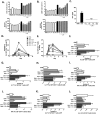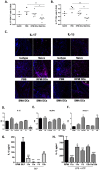Dendritic cells provide a therapeutic target for synthetic small molecule analogues of the parasitic worm product, ES-62
- PMID: 28490801
- PMCID: PMC5431997
- DOI: 10.1038/s41598-017-01651-1
Dendritic cells provide a therapeutic target for synthetic small molecule analogues of the parasitic worm product, ES-62
Abstract
ES-62, a glycoprotein secreted by the parasitic filarial nematode Acanthocheilonema viteae, subverts host immune responses towards anti-inflammatory phenotypes by virtue of covalently attached phosphorylcholine (PC). The PC dictates that ES-62 exhibits protection in murine models of inflammatory disease and hence a library of drug-like PC-based small molecule analogues (SMAs) was synthesised. Four sulfone-containing SMAs termed 11a, 11e, 11i and 12b were found to reduce mouse bone marrow-derived dendritic cell (DC) pathogen-associated molecular pattern (PAMP)-induced pro-inflammatory cytokine production, inhibit NF-κB p65 activation, and suppress LPS-induced up-regulation of CD40 and CD86. Active SMAs also resulted in a DC phenotype that exhibited reduced capacity to prime antigen (Ag)-specific IFN-γ production during co-culture with naïve transgenic TCR DO.11.10 T cells in vitro and reduced their ability, following adoptive transfer, to prime the expansion of Ag-specific T lymphocytes, specifically TH17 cells, in vivo. Consistent with this, mice receiving DCs treated with SMAs exhibited significantly reduced severity of collagen-induced arthritis and this was accompanied by a significant reduction in IL-17+ cells in the draining lymph nodes. Collectively, these studies indicate that drug-like compounds that target DCs can be designed from parasitic worm products and demonstrate the potential for ES-62 SMA-based DC therapy in inflammatory disease.
Conflict of interest statement
The authors declare that they have no competing interests.
Figures



 p < 0.05 compared to OVA DCs and
p < 0.05 compared to OVA DCs and  p < 0.05 and
p < 0.05 and  p < 0.01 compared to OVA+LPS DCs.
p < 0.01 compared to OVA+LPS DCs.

Similar articles
-
Small molecule analogues of the immunomodulatory parasitic helminth product ES-62 have anti-allergy properties.Int J Parasitol. 2014 Aug;44(9):669-74. doi: 10.1016/j.ijpara.2014.05.001. Epub 2014 Jun 12. Int J Parasitol. 2014. PMID: 24929132 Free PMC article.
-
From the worm to the pill, the parasitic worm product ES-62 raises new horizons in the treatment of rheumatoid arthritis.Lupus. 2015 Apr;24(4-5):400-11. doi: 10.1177/0961203314560004. Lupus. 2015. PMID: 25801883 Review.
-
Testing small molecule analogues of the Acanthocheilonema viteae immunomodulator ES-62 against clinically relevant allergens.Parasite Immunol. 2016 Jun;38(6):340-51. doi: 10.1111/pim.12322. Parasite Immunol. 2016. PMID: 27059010 Free PMC article.
-
The helminth product, ES-62 modulates dendritic cell responses by inducing the selective autophagolysosomal degradation of TLR-transducers, as exemplified by PKCδ.Sci Rep. 2016 Nov 21;6:37276. doi: 10.1038/srep37276. Sci Rep. 2016. PMID: 27869138 Free PMC article.
-
Filarial nematode secreted product ES-62 is an anti-inflammatory agent: therapeutic potential of small molecule derivatives and ES-62 peptide mimetics.Clin Exp Pharmacol Physiol. 2006 May-Jun;33(5-6):511-8. doi: 10.1111/j.1440-1681.2006.04400.x. Clin Exp Pharmacol Physiol. 2006. PMID: 16700887 Review.
Cited by
-
Immunomodulation by Helminths: Intracellular Pathways and Extracellular Vesicles.Front Immunol. 2018 Oct 12;9:2349. doi: 10.3389/fimmu.2018.02349. eCollection 2018. Front Immunol. 2018. PMID: 30369927 Free PMC article. Review.
-
The parasitic worm product ES-62 normalises the gut microbiota bone marrow axis in inflammatory arthritis.Nat Commun. 2019 Apr 5;10(1):1554. doi: 10.1038/s41467-019-09361-0. Nat Commun. 2019. PMID: 30952846 Free PMC article.
-
Chi3l3: a potential key orchestrator of eosinophil recruitment in meningitis induced by Angiostrongylus cantonensis.J Neuroinflammation. 2018 Feb 2;15(1):31. doi: 10.1186/s12974-018-1071-2. J Neuroinflammation. 2018. PMID: 29391024 Free PMC article.
-
Failure of the Anti-Inflammatory Parasitic Worm Product ES-62 to Provide Protection in Mouse Models of Type I Diabetes, Multiple Sclerosis, and Inflammatory Bowel Disease.Molecules. 2018 Oct 17;23(10):2669. doi: 10.3390/molecules23102669. Molecules. 2018. PMID: 30336585 Free PMC article.
-
Suppression of inflammatory arthritis by the parasitic worm product ES-62 is associated with epigenetic changes in synovial fibroblasts.PLoS Pathog. 2021 Nov 8;17(11):e1010069. doi: 10.1371/journal.ppat.1010069. eCollection 2021 Nov. PLoS Pathog. 2021. PMID: 34748611 Free PMC article.
References
Publication types
MeSH terms
Substances
Grants and funding
LinkOut - more resources
Full Text Sources
Other Literature Sources
Research Materials

